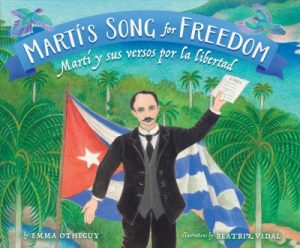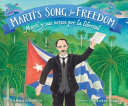

Reviewed by Beverly Slapin
Review Source: De Colores: The Raza Experience in Books for Children
Book Author: Emma Otheguy
Guantanamera, guajira guantanamera
Guantanamera, guajira guantanamera
Yo soy un hombre sincero
De donde crece la palma,
Yo soy un hombre sincero
De donde crece la palma
Y antes de morir, me quiero
Echar mis versos del alma
Guantanamera, guajira guantanamera
Guantanamera, guajira guantanamera
Every Cuban child knows the lyrics to the folk song, “Guantanamera,” the national song of Cuba. “Guantanamera” is an adaptation of several stanzas from José Martí’s Versos sencillos (Simple Verses), the last of his works to be published before his death in 1895; and since the American folk music revival in the 1960s, “Guantanamera” has been popular in the US as well.
A fierce yet gentle poet-revolutionary who fought against all forms of injustice, from slavery to colonialism, José Julián Martí Pérez is a national hero of the Cuban people. His many writings, along with thousands of images of him—in books, paintings, drawings, posters and on statues—can be found all over Cuba, and a gigantic marble memorial to him stands in Havana’s Plaza de la Revolución.
As a young man, Martí—affectionately called “Pepe”—found himself at the apex of what was to become a great struggle for the liberation of Latin America from Spain, and US intervention as well. He continues to be adored by the Cuban people and all who work for justice, and Marti’s Song for Freedom / Martí y sus versos por la libertad is the story of his early life, his first encounters with oppression, his organizing in Cuba and the US, and his joining the armed struggle for freedom.
In a series of paired stanzas, Otheguy and Domínguez each tell portions of Martí’s life and struggles in the style of Versos sencillos, his most famous work. Especially appealing are the placements of the English text and translation of a verso alongside the Spanish translation and one of Martí’s original versos, so that both hablantes and English-speakers can look from one to the other and examine them together. Continue reading about Marti’s Song for Freedom.
Trabajamos para los niños, porque los niños son los que saben amar, porque los niños son la esperanza del mundo. Y amamos que nos aman, y nos ven como algo de sus corazones.
We work for children because children are those who know how to love, because children are the hope of the world. And we love that they love us, and see us as something from their hearts.
—José Martí, La Edad de Oro, 1881


Marti's Song for Freedom by Emma Otheguy
Illustrator: Beatriz Vidal
Published by CHILDRENS BOOK Press on 2017
Genres: Biography and Autobiography, Caribbean, Latinx, Poetry
Pages: 32
Reading Level: Grades 3-5
ISBN: 9780892393756
Review Source: De Colores: The Raza Experience in Books for Children
Pubisher's Synopsis:
As a young boy, Jose Marti he traveled to the countryside of Cuba and fell in love with the natural beauty of the land. During this trip he also witnessed the cruelties of slavery on sugar plantations. From that moment, Marti began to fight for the abolishment of slavery and for Cuban independence from Spain through his writing. By age seventeen, he was declared an enemy of Spain and was forced to leave his beloved island. Marti traveled the world and eventually settled in New York City. But the longer he stayed away from his homeland, the sicker and weaker he became. On doctor's orders he traveled to the Catskill Mountains, where nature inspired him once again to fight for freedom. Here is a beautiful tribute to Jose Marti, written in verse with excerpts from his seminal work, Versos sencillos. He will always be remembered as a courageous fighter for freedom and peace among all men and women.
Leave a Reply